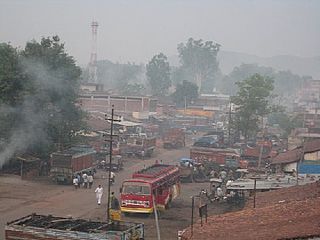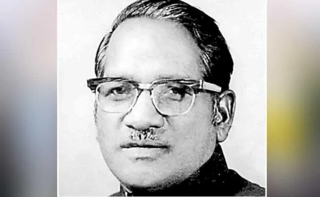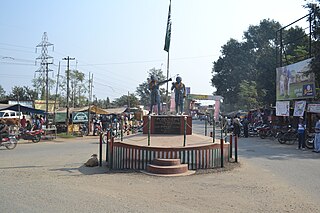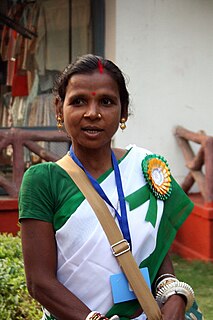Related Research Articles

Jharkhand is a state in eastern India. The state shares its border with the states of West Bengal to the east, Chhattisgarh to the west, Uttar Pradesh to the northwest, Bihar to the north and Odisha to the south. It has an area of 79,716 km2 (30,779 sq mi). It is the 15th largest state by area, and the 14th largest by population. Hindi is the official language of the state. The city of Ranchi is its capital and Dumka its sub-capital. The state is known for its waterfalls, hills and holy places; Baidyanath Dham, Parasnath, Dewri and Rajrappa are major religious sites. The state was formed on 15 November 2000, after carving out what was previously the southern half of Bihar.

Dhanbad is the second-most populated city in the Indian state of Jharkhand after Jamshedpur. It ranks as the 42nd largest city in India and is the 33rd largest million-plus urban agglomeration in India. Dhanbad shares its land borders with Paschim Bardhaman district and Purulia district of West Bengal and Bokaro, Giridih and Jamtara districts of Jharkhand. The city is called the 'Coal Capital of India' for housing one of the largest coal mines of India. The prestigious institute, Indian School of Mines is situated in Dhanbad. Apart from coal, it has also grown in information technology.

Sindri is a neighbourhood in Dhanbad in Dhanbad Sadar subdivision of Dhanbad district in Jharkhand state, India.

East Singhbhum is one of the 24 districts of Jharkhand, India. It was created on 16 January 1990. More than 50% of the district is covered by dense forests and mountains, where wild animals once roamed freely. It is known for being a centre of industry since Jamshedpur, the most populous city in Jharkhand, is located here.

Latehar is a town which is a headquarter of Latehar district of Jharkhand state, it is known for its natural environment, forest, forest products and mineral deposits. Latehar remained a part of Palamau District as a sub division since 1924. It was elevated from sub divisional status to a district on 4 April 2001, vide Jharkhand Government Notification No 946 dated 04.04.2001. Latehar is located on the north–west corner of Jharkhand in the Palamau Commissionary. It is surrounded by Ranchi, Lohardaga, Gumla, Palamu and Chatra district apart from Chhattisgarh state and district headquarters is situated at 84.51198 East Longitude and 23.741988 North Latitude.

Baba Kartik Oraon was an Indian politician and an Adivasi leader from Indian National Congress. He also participated in Indian freedom movement of 1947. He also found the Organisation "Akhil Bharatiya Adivasi Vikas Parishad".
The Biharis is a demonym given to the inhabitants of the Indian state of Bihar. Bihari people can be separated into three main Indo-Aryan ethnolinguistic groups, Bhojpuris, Maithils and Magadhis. They are also further divided into a variety of hereditary caste groups. In Bihar today, the Bihari identity is seen as secondary to caste/clan, linguistic and religious identity but nonetheless is a subset of the larger Indian identity. Biharis can be found throughout India, and in the neighbouring countries of Nepal, Pakistan and Bangladesh. During the Partition of India in 1947, many Bihari Muslims migrated to East Bengal. Bihari people are also well represented in the Muhajir people of Pakistan because of Partition.

Jadugora is a census town in the Musabani CD block in the Ghatshila subdivision of the Purbi Singhbhum district in the Indian state of Jharkhand.

Jharia is a neighbourhood in Dhanbad city in Dhanbad Sadar subdivision of Dhanbad district in Jharkhand state, India. Jharia's economy is heavily dependent on the local coal fields, used to make coke. However, fires in the coal fields have made the city heavily polluted, with several government studies recommending relocation of much of the population to nearby Belgaria.
Sundhi also known as Sodhi or Sundi or Sudi or Sudhi or Shoundika, is an Indian caste whose traditional occupation has been brewing of alcoholic drinks. According to Suratha Kumar Malik, Sundhi castes belong to the Dalit community, who are hooch traders and do small businesses. The Sundhis are included in the Other Backward Class category in the states of Bihar, Jharkhand and Odisha; and in the Scheduled Caste category in West Bengal, where they are also known as Shunri.

The red corridor, also called the red zone, is the region in the eastern, central and the southern parts of India where the Naxalite–Maoist insurgency has the strongest presence. It has been steadily diminishing in terms of geographical coverage and number of violent incidents, and in 2021 it was confined to 25 "most affected" and 70 "total affected" districts across 10 states in two coal rich, remote, forested hilly clusters in and around Dandakaranya-Chhattisgarh-Odisha region and tri-junction area of Jharkhand-Bihar and-West Bengal.

The Ho or Kolha people are an Austroasiatic Munda ethnic group of India. They call themselves the Ho, Hodoko and Horo, which mean 'human' in their own language. Officially, however, they are mentioned in different subgroups like Kolha, Mundari, Munda, Kol and Kolah in Odisha. They are mostly concentrated in the Kolhan region of Jharkhand and Odisha where they constitute around 10.7% and 7.3% of the total Scheduled Tribe population respectively, as of 2011. With a population of approximately 700,000 in the state in 2001, the Ho are the fourth most numerous Scheduled tribe in Jharkhand after the Santals, Kurukhs, and Mundas. Ho also inhabit adjacent areas in the neighboring states of Odisha, West Bengal and Bihar bringing the total to 806,921 as of 2001. They also live in Bangladesh and Nepal.

Ram Dayal Munda, known as R. D. Munda, was an Indian scholar and regional music exponent. He was awarded the Padma Shri of the year 2010 for his contribution to the field of art.

Musahar or Mushahar are a Dalit community found in the eastern Gangetic plain and the Terai. They are also known as Banbasi.The other names of the Musahar are Bhuiyan and Rajawar Their name literally means 'rat-eater' due to their main former occupation of catching rats, and there are many who are still forced to do this work due to destitution and poverty.
The Jaduguda Mine is a uranium mine in Jaduguda village in the Purbi Singhbhum district of the Indian state of Jharkhand. It commenced operation in 1967 and was the first uranium mine in India. The deposits at this mine were discovered in 1951. As of March 2012, India possesses eight functional uranium mines, including this Jaduguda Mine. A new mine, Tummalapalle uranium mine is discovered and mining is going to start from it.
Ramnika Gupta was an Indian writer, activist and politician. She was the founder and President of Ramnika Foundation, member of the CPI(M), a tribal rights champion, former trade union leader, politician, writer and editor. She was the coordinator of the All India Tribal Literary forum. She was a Member of the Bihar Legislative Assembly from 1979–1985.
Jharia coalfield is a large coal field located in the east of India in Jharia, Jharkhand. Jharia represents the largest coal reserves in India having estimated reserves of 19.4 billion tonnes of coking coal. The coalfield is an important contributor to the local economy, employing much of the local population either directly or indirectly.
Kharsawan block is a CD block that forms an administrative division in the Seraikela Sadar subdivision of Seraikela Kharsawan district, in the Indian state of Jharkhand.
Tailing Pond is a documentary film that highlights how tribal families in Jadugora, Jharkhand are experiencing harmful effects of uranium radiation exposure. The documentary is produced & directed by Saurav Vishnu and narrated by Cynthia Nixon. Tailing Pond is officially in consideration for the 93rd Academy Awards in the Documentary – Short category.

Dalits in Bihar are a social group composed of many Scheduled Castes, placed at the bottom of the "caste-based social order". The Dalits also include some of the erstwhile untouchable castes, who suffered various forms of oppression in the feudal-agrarian society of Bihar. Some of the Dalit castes have specific cultural practices, which differ from those of orthodox Hinduism. In the post-independence period, the failure of land reform led to lack of socio-economic mobility among them, in contrast to the agricultural castes. This led to increase in caste based strife between the Dalit supported Naxalite groups and the state authorities backed by the dominant social groups. In the meantime, many caste-based private armies were formed in state, by the landlord class, in order to quell the Dalit assertion under the banner of Maoism. Ranvir Sena was the most dreaded caste based militia of the landlords, and perpetrated a number of massacres against the Dalits. Some of the Backward Castes also emerged as landlords, due to partial success of the Green Revolution and land reform, and Dalits came into conflict with them as well. In the later years, socio-political assertion was witnessed in Dalits of Bihar. After 1990s, many welfare drives were undertaken by the Government of Bihar to improve the condition of Dalits.
References
- ↑ "Truth, people and a video camera". InfoChange India. 6 January 2009. Archived from the original on 6 January 2009. Retrieved 27 February 2017.
{{cite web}}: CS1 maint: unfit URL (link) - ↑ IMC India – The Fire Within – a film by Shriprakash Archived 9 July 2008 at the Wayback Machine
- ↑ Documentary Films on Musahars Culture & Identity | Documentary Films on Dalit Community Archived 6 September 2007 at the Wayback Machine